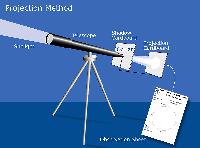

The Venus Transit 2004
... for Students and Teachers!
| | Welcome!The VT-2004 programme is aimed at students and teachers in schools all over Europe, indeed on all continents. The fact that Venus transits are so rare - the last one happened in the year 1882 - makes all of us extremely privileged to witness one this year. It is a unique opportunity for young people to witness a celestial phenomenon that most will never again see in their lifetime and which their children will most likely never see. Do not miss this chance! It would be a real pity not to "participate" in this great event in some way, either individually or as a group (schoolclass). [It is true that another Venus Transit will happen in 2012, but it will not be visible in Europe.] What to do ?This VT-2004 website helps students and their teachers to enjoy this event and learn from it. It provides you with information and possibilities for active participation (click on the images to the left to see some typical examples), e.g.:
Whatever you choose to do, we wish you much fun and not least, clear skies where your are at the time of Venus Transit on June 8, 2004! Do Your OWN Observations!Students and Teachers who would like to perform observations of Venus and the Sun are invited to study the webpage on "How to Observe". It includes detailed "Guidelines for Observers" that have been written specifically for school classes. It will add a whole new dimension if you decide to participate in the VT-2004 Observing Campaign. This means that you must register before with the VT-2004 programme and then deliver your observations during the Venus transit event. This is not difficult - you will find clear instructions via that page. There is also an opportunity for the more advanced to employ the VT-2004 VT-2004 easy-to-use image processing facility. TV-film about school observations etc.Of particular interest will be a preview of the first part (about 1/3) of the 28-min TV-film about the Venus Transit and the VT-2004 programme, now available here; it concerns observations of the transit and the involvement of school students and their teachers . The film is now in the final production stage in the Czech Republic and the preview may be downloaded from this website [MPG - 83.4 Mb; 11 min; English version], together with an English transcript [Word - 40k and [PDF - 80k]; and also from the special page at the website of the VT-2004 Czech Node. Teachers' GuideThe European Association for Astronomy Education (EAAE) has prepared a special easy-to-use Teachers' Guide ( Word, 160 k; PDF, 95k) for busy teachers who would like to introduce their students to the VT-2004 event but have little time to spare, both in preparation for this and in class. Educational MaterialHere is an overview of the Educational Material that is now become available within the VT-2004 programme. It has been prepared for different study levels in a joint effort by teachers from different European countries. English and other languagesWhile the material at this central VT-2004 website is all in English, information about the Venus Transit suitable for students and teachers in other languages is now available at the websites of several VT-2004 National Nodes. It may also be useful to look at the comprehensive Students' and Teachers' Mercury Transit page, as well as the related Short Notes where much information is available in many different languages. Educational SheetsA series of Educational Sheets has been prepared with suggestions for class activities before and during the Venus Transit. They have been classified in three levels (1 to 3) of increasing complexity.
PPT-Presentations etc.The following power-point presentations are available that offer guidance for school activities in connection with the Venus Transit:
Moreover, the following article provides a very useful introduction to the transit:
AnimationsVarious animations to illustrate the Venus Transit are also available. Links to other animations and also found on this page and via the Links' page. Last year, in ESO's Catch a Star ! competition, a group of students made a very nice project on Venus and its phases, with an animation. It is worth a look ! Questions?If you have questions in connection with the VT-2004 Educational Materials , please do not hesitate to contact the organisers via email at vt-2004@eso.org. |

